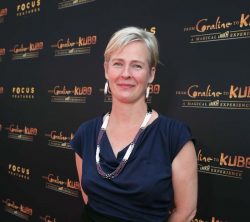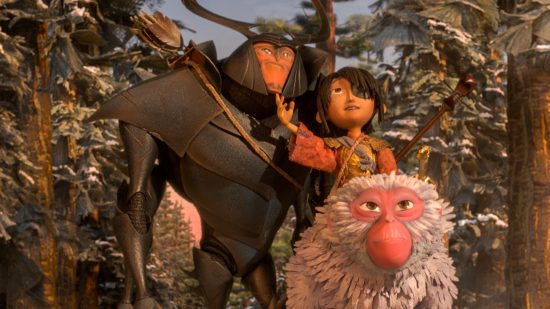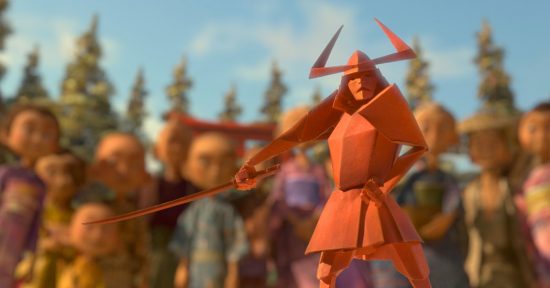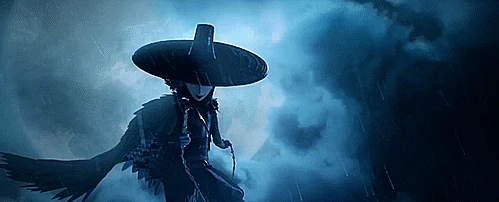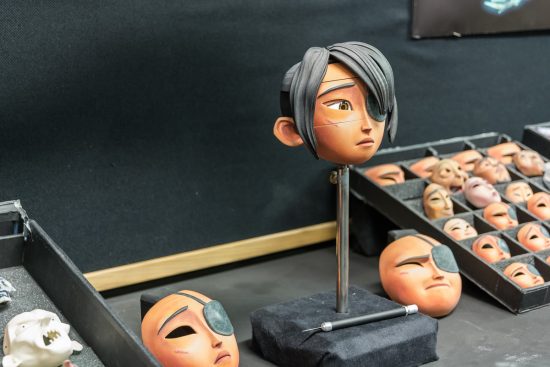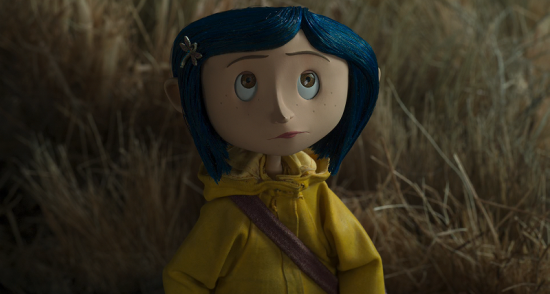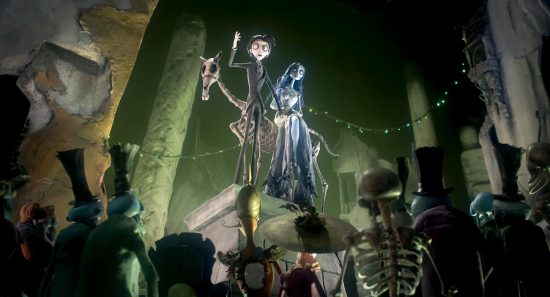LAIKA’s Head of Puppets, Georgina Hayns, talks about Kubo and the Two Strings
From acclaimed animation studio LAIKA, creators of the Academy Award®-nominated movies Coraline, ParaNorman and The Box Trolls, comes an all-new epic quest adventure: Kubo and the Two Strings. Starring the voice talents of Academy Award® winners Charlize Theron (Mad Max: Fury Road) and Matthew McConaughey (Interstellar). Young Kubo (voiced by Art Parkinson of “Game of Thrones”) mesmerizes the people in his village with his magical gift for spinning fantastical tales. When he accidentally summons an evil spirit seeking vengeance, Kubo journeys on an action-packed quest to solve the mystery of his fallen samurai father, discover his own magical powers, and reunite his family.
Kubo and the Two Strings stars an all-star supporting voice cast including George Takei (Star Trek), Cary-Hiroyuki Tagawa (“The Man in the High Castle”), and Academy Award® nominees Ralph Fiennes (Harry Potter), Brenda Vaccaro (“Johnny Bravo”), and Rooney Mara (The Girl with the Dragon Tattoo). The Blu-ray™and DVD are packed with exciting behind-the-scenes bonus content, featuring the filmmakers and incredible voice cast, that allows viewers to dive even deeper into the magical story.
Kubo and the Two Strings is out now to download and available on DVD and Blu-Ray on the 16th of January.
We recently caught up with Georgina Hayns – the Head of Puppets at LAIKA. Georgina was great, incredibly knowledgable fun to talk to and told us all about getting attached to origami fire-breathing chicken’s, Tim Burton, and what’s next for LAIKA.
Hi Georgina, I’m Alan from Live for Films, how are you doing today?
I’m doing well, thank you, Alan.
I loved Kubo…
Oh, thank you!
…so I have lots of things I would like to ask you about. So you were the Head of Puppets on Kubo, can you explain to me what that means and entails? What does a typical day look like for you?
Yeah, absolutely! My job is really the conduit of information between the director, the production designer, the Head of Animation, and then a team of amazing puppet makers. We have about seventy puppet makers that work with us and it’s all different disciplines of arts and crafts that builds a puppet, so we have sculptors and mould makers and casters and sort of fine silver smiths that make the internal skeletons – the armatures – we have a team of costume makers, a costume designer, and then we have the hair department and a paint department, and sort of a whole team of people that works on the heads and the faces and the replacement faces, so there’s a lot of artists that need information, and the correct information, so that they can build the puppet so that it does everything, so it’s basically my job to make sure that they have all of the design work that they need and meeting with the teams to technically break down how we’re going to make what starts of as a drawn design, and then a sculpted static maquette. We then have to turn that into a fully functioning action puppet for stop motion.
So do you get a fairly detailed brief at the start or do you have a lot of creative freedom? And then is there a lot of back and forth?
All of the above! [laughs] We need a lot of information at the beginning about what this puppet needs to do. We need to know what it looks like, and we need to know sort of the key style guide elements that are important in the movie. So a lot of that is figured out in the illustration and then the maquette at the beginning, and then the performance is figured out through the storyboards and the script. But what happens is generally… You know scripts and storyboards are evolving throughout the filming process, so you often start making a puppet that might be a background character that can sort of evolve into more of a “hero” character.
So there are changes as you’re going, but generally I would say that most of the characters that we make at LAIKA, we do need to know a lot about what they need to do at the beginning. What we’ll do is we have different stages of the build. We’ll have sort of a prototype build of the mock-up, if it’s a technically challenging puppet, that we’ll do before we make the final thing. We’ll get it animation tested and we’ll have a “look development” team that will decide what materials we’re going to use to make the final look of the puppet work with the movie. So there’s a lot of back and forth between the Head of Animation and the director and our puppet department – we need a lot of information from those guys.
It sounds like you really have to juggle practicality and artistry in your role. That you need to ensure that a puppet not only looks great but can also do what it needs to do technically as well, right?
Yeah! And you know that is the most challenging thing about puppet making. And especially the level of puppet making that we have come to be used to at LAIKA, because our films are really quite stylised and each movie we take on a different look and a different stylisation. For us, the most challenging is to make a “graphic” movie because we’re dealing with fabrics and hair and fur – yet we’re trying to make it look straight-lined with nice angles and silhouettes, and all those materials don’t want to do any of that! So the materials all also have to have a form – using some kind of mechanism or backing.
When you so spend so long working on these puppets do you find yourself getting attached to certain ones? Did you have a favourite while you were making Kubo?
You know, oh! I really loved some of the origami characters! Origami Hanzo probably has the biggest role of an origami character in the movie, but the character of the chicken…
I was just going to say “the fire-breathing chicken”! You read my mind!
[laughs] Yeah! I got really attached to that one, just in terms of what it had to do, and the comedy aspects of it. But also the scene where Mother is telling the story of how she met Hanzo for the first time. That has a slightly different stylisation, it’s made out of origami leaves and flowers rather than the paper but it just has this beautiful sort of… Both of those puppets were very small, they were only four to five inches tall, and yet they just have so much performance in them as these little sort of paper leaf-like characters. So they were probably some of my favourite puppets that really you only see for a couple of minutes.
My favourites were the sisters, the two bad sisters with the hats…
Yes! You see… yes! In my sort of puppet making career, as “hero” puppets, I would have to say that they are two of the most beautifully designed puppets that we’ve worked on. It’s interesting because this day and age everyone wants all action all performance everything, and I think the strongest thing about the sisters is that they just have those masks. Their mouths never move, their faces never move, and it made them really scary!
Definitely! They are very sinister. How do you go about conveying emotion in characters like that where you’re hands are tied and you can’t use their faces or mouths?
Well thankfully the initial designs were already quite sinister! They already had the hat, the mask, the sort of deep blue black oily colour palette of the puppets – so they already had that “oooooh creepy!” feel. Then it’s really down to the animator and what they bring to our puppets. We build something that has a metal skeleton inside it and some wires in the costume and it looks beautiful but it’s really how about they breath life into them. Our animators are amazing at LAIKA, they are geniuses. What they do with the puppets that we make astounds me every day, so it’s really down to them… and a little bit of my team as well! [laughs]
I’ve been to exhibitions and things and seen some of the metal armatures you were talking about for Ray Harryhausen’s puppets. Has that process changed very much over the years? Are the puppets a lot more advanced now, or is basically still the same sort of methodology?
It is very much the same as it’s always been. I mean, you look at the skeleton that was used in King Kong and you look at some of the armature that we made for the character Beatle and the technique is exactly the same, it’s just that the tools and the machinery that we use to build it with has improved ten fold over the decades since that movie was made. I’ve been in the industry for twenty-five plus years at this point and I watched the technology grow, and the toolset that we have at our disposal now is unbelievable in comparison to when I started. Yet, we’re still using: metal armatures, silicon for skin, foam latex for softer bigger characters; it’s very much the same toolkit but we add whatever we see that we could use from the technological world.
Like 3D printing?
Yes. We’ve become quite famous for our use of 3D printing for the replacement faces and I think that kind of revolutionised stop motion as people know it because stop motion animation was always seen as a little bit of a clunky form of animation because you couldn’t get that much performance out of the faces, and with drawn animation everything was fluid. What we’ve been able to do with 3D printing is bring that “squash and stretch” into the facial performances of our characters, and we are printing literally thousands of faces for each character to allow them to get full range, and more than what you would expect from a human character’s facial expressions. So we’re not at all afraid of using new technology, but we’re also not afraid of still using the traditional techniques that are tried and tested in stop motion.
I think maybe that’s why stop motion is still so special to people, because when you come down to it they are physical items that have been made by hand and animated by hand – those characters are embodiments of time and effort and craft and love.
Yes! There’s definitely a magic in stop motion animation. I’m the Queen Luddite that doesn’t know how to switch a computer on! I love making things, and I love the real world, and I think that stop motion is a way to view the real world through a fantasy eye in a way. There’s definitely… In the world that we live in now we are bombarded by digital imagery, it’s all around us, and I think that kids and adults alike – they see stop motion and they don’t even know what is different about it, but they’re drawn to it because it’s a real object in a real space.
Do you mind talking a little bit about your work on some of the other LAIKA films that I have particularly enjoyed?
Oh no, not all. You go for it!
Great. Thank you. So you worked on Coraline too – were there any particular challenges that you encountered in the making of that film?
Oh, well you know, Coraline was the first film we made at LAIKA, so that was a challenge, because we were building the studio, we were building the team. I arrived here eleven years ago and there wasn’t a team of puppet makers, or a studio, so we built all of that while we were making the film of Coraline. I’d been making films for fifteen years before that and had just come off Tim Burton’s Corpse Bride, but it was a whole different kind of puppet making with a different kind of people and a different director, so in many ways it was very challenging from day to day, but it was also incredibly rewarding because we knew we were building the foundations of this very special studio that we hoped would grow and establish itself in the world of animation – which I think we have done.
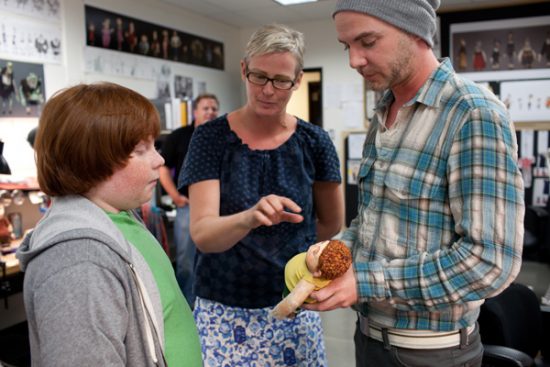
Supervisor of Puppet Fabrication Georgina Hayns and co-director Chris Butler review the Neil puppet for ParaNorman
And what about ParaNorman, which is a personal favourite of mine, what…
Good! I like ParaNorman too!
Yay! Team ParaNorman! Were there any puppets that you made for that one that you were particularly proud of?
You know, I love Prenderghast, I love Alvin… ParaNorman is still one of my favourites design wise, because it had such a strong design to it, and that was the first film that Nelson Lowry was production designer on and I think you can really see his influence that he brought because he’s very strong on design and stylisation. So a lot of the characters in ParaNorman I loved because I loved there sort of odd proportions and… of course the zombies – they were great fun!
I bet! You mentioned your work with Tim Burton on The Corpse Bride, but you also worked on Mars Attacks! didn’t you?
Yeah, wayyyy back! That was a really interesting introduction to Hollywood for me, and my puppet making career, because up until that point we’d done a lot of British kids TV – The Wind in the Willows, Bob the Builder, Noddy – and also a lot of commercials and short films, but when we got the phone call from Tim Burton’s office is was quite a monumental day of “AAAAARRRRGGGHHH Tim Burton is on the line!” We’re in Manchester, and none of us had been to America or Hollywood or anything, and it was an amazing opportunity that then ended sadly with it all not going to stop motion animation, and ending up as a computer generated movie. But we still made seventy puppets which went to Industrial Light and Magic, and they used those puppets as computer scanning aids. Then we also made all of the life-sized dead martians that were being scooped up at the end of the movie!
Cool. That must have been fun.
It was a lot of fun! And we also… it was through Mars Attacks! that we then got the phone call ten years later to work on Corpse Bride. So Tim already had a dream to make Corpse Bride and was figuring out how to get the money and everything together, but he said “I will call you as soon as Corpse Bride comes up” and he did!
And then how was Corpse Bride?
It was an amazing experience because it was the first stop motion feature in that style – Aardman had done a few in claymation – but this was the first in latex skin or replacement animation style, this was the first one since Monkeybones, which had been made in America. So it was a new generation of puppet makers, animators, set builders; it was the coming together of a team that are the foundations of LAIKA.
Wow. What are you doing at LAIKA next?
We’re actually halfway into the next movie. It’s top secret, I can’t tell you anything about it! But it’s pretty cool, it’s… yeah… I’m pretty excited to be working on it. We’d actually started working on this next movie before we’d finished filming on Kubo. So this is the first time we’ve crossed over productions.
Oh, OK. And is it like how you were saying before about visually and stylistically the films are all very different from each other, is this another genre to what you’ve tackled before?
It is! It is all of the above! And that’s all I can say!
Fair enough! Well whatever it turns out to be I am really looking forward to it. Thank you very much for taking the time to talk to me today, Georgina. I’ve really enjoyed it.
Thanks very much. It’s been great talking to you too.
Kubo and the Two Strings is available on VOD, DVD and Blu-Ray in the UK on the 16th of January.

